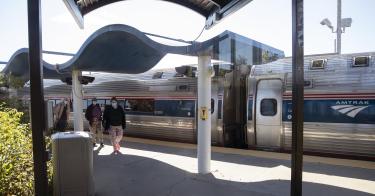This week, the House of Representatives is expected to consider its massive $547 billion surface transportation bill.
Unfortunately, instead of focusing on how we can make better use of existing infrastructure, such as by reducing regulatory barriers, the legislation would actually increase regulatory barriers that would hinder the use of existing infrastructure.
There is one harmful regulatory barrier that is emblematic of the regulatory absurdities contained in the bill: a prohibition on having fewer than two people in a freight train’s locomotive cab.
Some freight railroads have been able to reduce the number of locomotive crew members from two employees down to one. Even passenger rail, such as Amtrak, for which an accident would pose a greater risk for loss of human life as compared to freight rail, has been using one-person locomotive crews (this doesn’t include conductors and other workers who are on board to assist passengers).
Despite claims to the contrary, the evidence doesn’t show that two-person crews are somehow safer than one-person crews. One-person crews have been operating trains safely around the world, particularly Europe, for decades. In a 2016 proposed rule that would have mandated a minimum of a two-person crew, the Federal Railroad Administration admitted that they “cannot provide reliable or conclusive statistical data” that one-person crews are safer or less safe than multiple-person crews.
In 2019, when the agency withdrew the proposed rule, it explained that this statement is still true today. It also explained that it “finds that no regulation of train crew staffing is necessary or appropriate at this time.”
A technology known as “Positive Train Control” makes it even more unreasonable to require two-person crew minimums. Not unlike automatic avoidance systems for cars, this technology can automatically take actions, such as slowing down a train, to avoid crashes.
It’s also worth noting that as crew sizes have declined over the years, rail safety has continued to improve.
Yet this new bill includes a provision that would prohibit one-person crews on all freight trains with limited exceptions. The legislation simply ignores the evidence and the innovations that exist in the railroad industry.
The likely reason for this unjustified regulation is to attempt to protect railroad jobs, although it is far from clear that such a regulatory scheme would achieve that objective.
Even if freight railroads reduce the locomotive crew from two to one, this doesn’t necessarily mean a specific position would be lost. For example, the largest railroads appear to want to simply redeploy the locomotive conductor to a ground-based position. Regardless, such a regulatory move is both inappropriate and short-sighted. Congress shouldn’t be in the business of dictating staffing decisions for private railroads that operate on privately-owned infrastructure.
By trying to use regulation to protect a specific type of job, legislators would be hindering the technology and innovation that can help the railroad industry, its customers, and its employees. Trying to protect one type of job today is likely hindering the ability of railroads to invest and create better jobs for tomorrow. It is also hindering railroads in their ability to better move freight in ways that can create more efficient and stable supply chains; this is something legislators should be well aware of in light of the pandemic.
As Congress considers our nation’s infrastructure, it should be considering how government at all levels (federal, state, and local) makes it more difficult to develop new infrastructure and best utilize our existing infrastructure. A regulation grounded in no evidence in what appears to be a misguided effort to provide a protectionist scheme for a specific type of job is precisely the type of regulation that Congress should be getting rid of, not creating.
This piece originally appeared in The Daily Signal.



